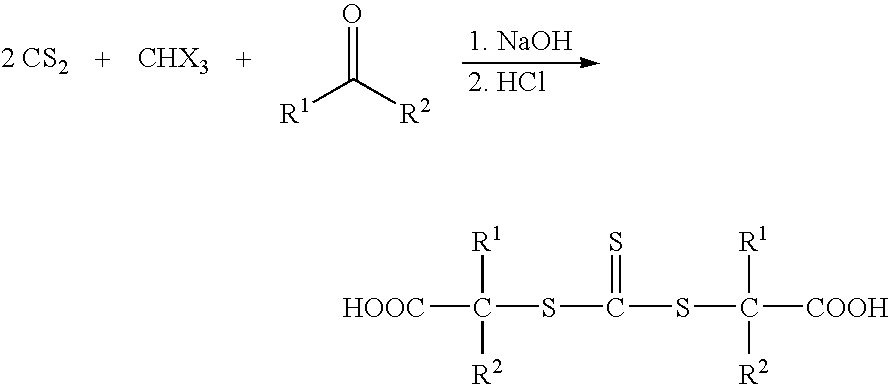Associative thickeners for aqueous systems
a technology of associative thickeners and aqueous systems, applied in the field of thiocarbonate compounds, can solve the problems that acrylic acid or acrylate associative thickeners typically exhibit inferior properties when compared to polyurethane, and achieve the effect of increasing the viscosity of the system
- Summary
- Abstract
- Description
- Claims
- Application Information
AI Technical Summary
Problems solved by technology
Method used
Image
Examples
example reaction mechanisms
, adding monomers having a hydrophobic group, as well as hydrophilic monomers to a thiocarbonate compound are as follows:
wherein b, b′, c, c′, n, R1, R2, R3, R14 and y are defined herein.
Once the polymerization reaction has been carried out to a desired degree, the thiocarbonate polymers or copolymers can be neutralized in any suitable base such as, but not limited to, ammonium hydroxide, sodium hydroxide, and potassium hydroxide. The polymer is preferably subsequently isolated by methods known to those of ordinary skill in the art before being utilized as an associative thickener. If the polymerization solvent is water, or water-soluble, then the aqueous solution of the neutralized polymer can be used directly.
The associative thickeners of the present invention are preferably utilized in aqueous compositions or systems intended for various purposes, but are particularly preferred for use in aqueous latex paints and coatings in order to modify viscosity and thereby improve the ...
example 1
5.78 grams trithiocarbonate, 50 grams Brij® 58 a hydrophobe group containing compound from Uniqema, and 0.5 gram p-toluene sulfonic acid were mixed in a 100 ml round bottom flask with a stirrer and heated to about 130° C. under 60 mmHg vacuum to distill off 0.15 ml water in 30 minutes using a condenser and a receiver. 0.5 g more of the acid was added and the distillation was continued at about 130° C. for 5 more hours to produce the product shown above. The contents of the flask were poured into a reaction vessel and used directly in the polymerization described in Example 2.
example 1b
In a 100 ml reaction vessel equipped with a magnetic stirrer, mantle, thermowatch, short-column condenser, cow receiver, and thermometers, 117.97 grams of hydrophobe group containing compound (Brij® 58) and 1.90 grams of p-toluenesulfonic acid monohydrate were added. The reactants were heated to about 80° C. and subsequently 36.4 grams of the trithiocarbonate compound was added. A partial vacuum to 60 mmHg mercury was applied and the temperature was increased to about 110° C. for a period of five hours to collect water that was formed and produce the product shown above. The product can be used “as is” as in Example 2B, or can be placed into toluene and washed with an aqueous base such as a 10% sodium hydroxide or sodium carbonate solution to remove residual acid catalyst, and then concentrated.
Polymerization of Hydrophilic Group Containing Repeat Units into Trithiocarbonate Hydrophobe Group Containing Compounds to Form Associative Thickeners
PUM
| Property | Measurement | Unit |
|---|---|---|
| viscosity | aaaaa | aaaaa |
| shear viscosity | aaaaa | aaaaa |
| hydrophobic | aaaaa | aaaaa |
Abstract
Description
Claims
Application Information
 Login to View More
Login to View More - R&D
- Intellectual Property
- Life Sciences
- Materials
- Tech Scout
- Unparalleled Data Quality
- Higher Quality Content
- 60% Fewer Hallucinations
Browse by: Latest US Patents, China's latest patents, Technical Efficacy Thesaurus, Application Domain, Technology Topic, Popular Technical Reports.
© 2025 PatSnap. All rights reserved.Legal|Privacy policy|Modern Slavery Act Transparency Statement|Sitemap|About US| Contact US: help@patsnap.com



